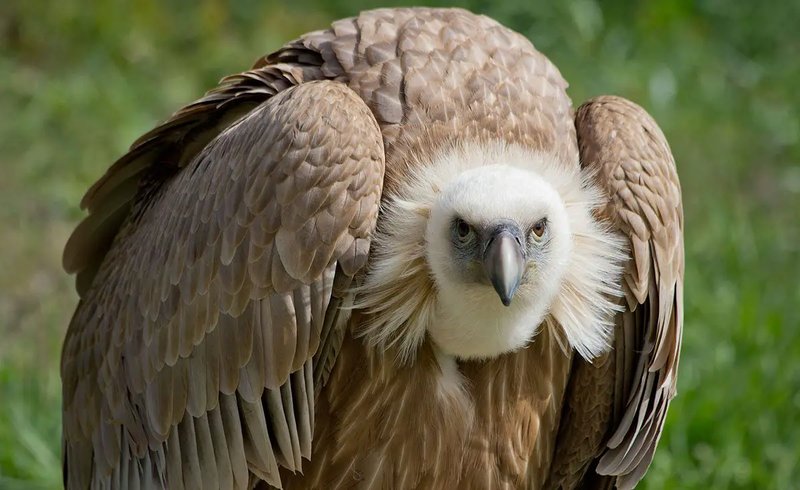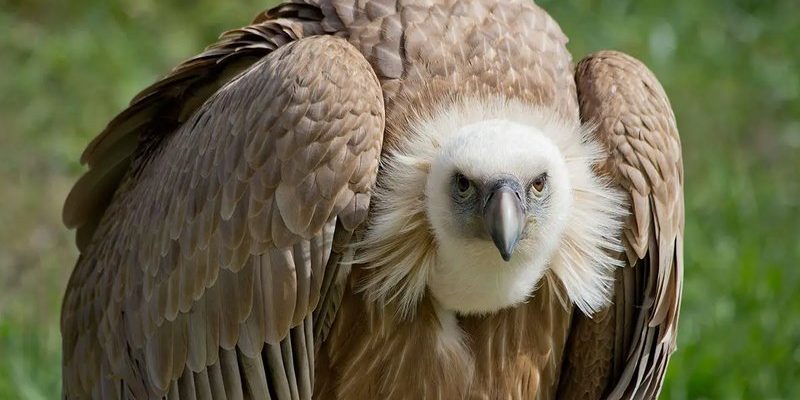
In this article, we’ll explore ten animals that resemble the Griffon Vulture, highlighting how they compare and how you can tell them apart. It’s like spotting different characters in a wildlife documentary; each has unique traits and behaviors that make them special. So, grab your binoculars—figuratively speaking—and let’s dive into the world of vultures and their look-alikes!
1. Egyptian Vulture
The **Egyptian Vulture** is a close relative of the Griffon Vulture. At first glance, you might think they’re similar, but they have some distinct features. For one, Egyptian Vultures are smaller, typically measuring around 23-27 inches in length. They also have striking yellow facial skin, which gives them a unique appearance compared to the Griffon’s more subdued look.
You might be wondering what else sets them apart. **Egyptian Vultures** are known for their unique behavior: they often use tools to break open eggs. They can be seen picking up stones and dropping them onto eggshells, displaying an unexpected level of intelligence. So, if you see a vulture doing a little rock tossing, you might just be looking at an Egyptian Vulture!
Key Distinctions
- Size: Egyptian Vultures are smaller than Griffon Vultures.
- Facial Color: Bright yellow skin versus the Griffon’s more muted tones.
- Behavior: Tool use for breaking eggs.
2. Bearded Vulture
Next on our list is the **Bearded Vulture**, also known as the Lammergeier. This bird is captivating, not just for its size but also for its unique color palette. With a wingspan that can exceed 9 feet, the Bearded Vulture has a striking reddish-brown plumage and a distinct beard-like feature.
While it also feasts on carrion, its diet consists primarily of bones! Yes, you heard that right. Bearded Vultures will often carry bones high into the air and drop them onto rocks to crack them open, making them quite unique among vultures. If you spot a vulture with long, dark wings and a caramel-colored body, you might just have a Bearded Vulture in your sights!
Key Distinctions
- Color: Reddish-brown feathers versus the Griffon’s pale tones.
- Diet: Primarily eats bones, unlike the Griffon’s focus on soft tissue.
- Beard-like Feature: Look for the distinctive “beard” on the Bearded Vulture.
3. Rüppell’s Vulture
The **Rüppell’s Vulture** is another fascinating relative, often found in Africa. One of its standout features is its high-altitude flying ability, which is the highest of any bird on record! This vulture can soar at altitudes over 37,000 feet, where it often searches for food.
Though Rüppell’s Vulture has similar body proportions to the Griffon Vulture, it has a more slender body and a smaller head. This makes it look a bit more delicate. If you’re birdwatching in Africa and see a lighter-colored vulture cruising at dizzying heights, it’s likely a Rüppell’s Vulture.
Key Distinctions
- Flying Ability: Can soar at extremely high altitudes.
- Body Structure: More slender than the Griffon Vulture.
- Feather Color: Lighter body with a different color palette.
4. Cinereous Vulture
Moving on to the **Cinereous Vulture**, sometimes called the black vulture. This bird is known for its powerful build and dark plumage. It can be mistaken for the Griffon Vulture due to its similar size, but the darker feathers and its impressive wingspan that often surpasses eight feet make it stand out.
Cinereous Vultures often prefer more rugged areas than the Griffon Vultures, which are typically found in open, hilly regions. If you see a large vulture with a dark, almost black coloration perched on a rocky ledge, you might be lucky enough to spot a Cinereous Vulture.
Key Distinctions
- Color: Dark plumage gives it the name “black vulture.”
- Habitat: Favors rugged terrains versus open hills.
- Size: Similar wingspan but heavier build.
5. Griffon Vulture (Young)
Interestingly, baby Griffon Vultures look quite different from their parents. As chicks, they have fluffy, white down feathers and are much smaller. They gradually adopt the adult’s characteristics as they mature over the years.
If you’re observing young Griffons, you’ll notice they tend to stay close to their nesting sites while learning essential survival skills from their parents. Their transformation over several months is fascinating to watch!
Key Distinctions
- Feather Color: Young have white down feathers compared to adults.
- Size: Much smaller than their fully-grown counterparts.
- Behavior: Often seen learning survival skills near nests.
6. Turkey Vulture
Now here’s a familiar face: the **Turkey Vulture**. These birds are widespread in North America and are often spotted in open fields or near highways, where they search for food. Turkey Vultures are smaller than Griffon Vultures, with a unique red head and a keen sense of smell, which helps them locate carrion.
While their flight style is similar, Turkey Vultures can be identified by their muted colors and their distinctive bald heads, which stay cleaner when feeding. If you see a vulture with a red head gliding low over a field, it’s probably a Turkey Vulture.
Key Distinctions
- Head Color: Red rather than gray.
- Size: Smaller than the Griffon Vulture.
- Feeding Behavior: Better sense of smell for finding food.
7. Black Vulture
The **Black Vulture** is another North American relative that you’re likely to encounter. With its dark plumage and distinctive white wing tips, it can be identified from afar. Unlike the Griffon Vulture, Black Vultures are more social and often hunt in groups.
While both species have a similar scavenger role, the Black Vulture has a shorter wingspan and a more compact body. If you see a vulture with a bold black appearance and frequenting with a group, there’s a good chance it’s a Black Vulture.
Key Distinctions
- Color: Completely dark feathers with white wing tips.
- Size: Shorter and stockier than Griffon Vultures.
- Social Behavior: More gregarious in nature.
8. Asian Vulture (Various Species)
The Asian continent is home to several vulture species that share similarities with the Griffon Vulture. This includes the **Himalayan Vulture** and **Indian Vulture**, both of which play essential roles in their ecosystems, similar to the role that Griffon Vultures play in Europe and Africa.
These vultures are usually characterized by their larger sizes and diverse habitats, ranging from mountainous regions to urban areas where they scavenge. They may closely resemble Griffon Vultures, but their color patterns and localized features differentiate them significantly.
Key Distinctions
- Habitat: Various terrains across Asia.
- Appearance: Varied feather patterns compared to Griffons.
- Size: Generally larger than Griffon Vultures.
9. Lammergeier (Bearded Vulture)
We’ve mentioned the Bearded Vulture already, but it’s worth emphasizing its unique characteristics. Known for its striking appearance and bone-eating habits, it’s an imposing figure in the sky. The Lammergeier’s wingspan rivals that of the Griffon Vulture, making it a magnificent sight in the air.
Coming back to its unique feeding habits, Lammergeiers often drop bones from cliffs to break them open—definitely a conversation starter at the birdwatching club! If you spot a vulture with dramatic color changes and a powerful wingspan, you’ll likely be looking at a Lammergeier.
Key Distinctions
- Feeding Habits: Unique bone-crushing behavior.
- Color: Distinctive feather colorations.
- Body Size: Comparable wingspan with a heavier body.
10. California Condor
Finally, let’s talk about the **California Condor**, one of the most iconic vultures in North America. While they differ from the Griffon Vulture in many ways, their size and scavenging behavior make them quite similar. California Condors have long wings and a stout body, coupled with a striking black-and-white appearance.
Unlike Griffon Vultures that tend to have more uniform feathering, California Condors are easily identified by their distinctive neck coloration. Watching a California Condor soar in the sky is a breathtaking experience, making their conservation particularly vital.
Key Distinctions
- Coloration: Black body with white wing panels.
- Habitat:** Unique to California and surrounding areas.
- Size: Comparable but with a different body shape.
In conclusion, while the **Griffon Vulture** has its own charm and significance in the ecosystem, it’s fascinating to explore the variety of other vulture species that share its habitat or behavior. By understanding these ten animals similar to the Griffon Vulture, you can enhance your birdwatching experience and deepen your appreciation for these extraordinary scavengers. Remember, each species has its unique traits, and knowing how to tell them apart adds a new layer of enjoyment to your wildlife encounters!

